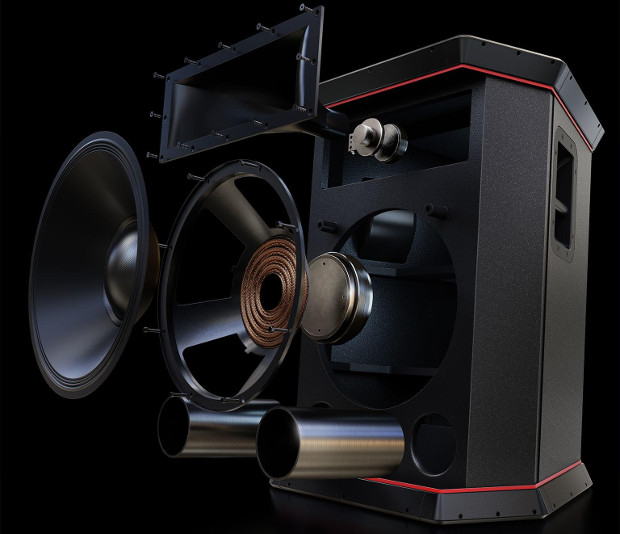The namesake of what we now call horn instruments or speakers most likely derives from the horns of cows, sheep or wild animals. The natural horn made of real horn or wood has been demonstrably used to amplify sound since antiquity and is thus certainly the oldest “device” for amplifying sound. If a horn loudspeaker is used nowadays, you can almost certainly assume that it is a first-class transducer. What is the acoustic secret of the funnel shape and how is it used in Hi-Fi applications?
Werner von Siemens and the original horn speaker
The horn as a sound intensifier has been accompanying mankind since ancient times and has surprisingly developed into a similar form in different cultures. The European alphorn (see cover picture) and the Australian digeridoo have indisputable similarities.
When multi-talented Werner von Siemens filed a patent for a “mobile coil transformer” in 1877, he was certainly not aware that more than 140 years later his original horn loudspeaker, described as a “cone membrane with an exponential horn”, would still be in use.

The acoustic principle behind horn speakers
Whether it’s a loudspeaker or an instrument, the horn always functions as a sound amplifier. The reason for this is the funnel-like shape of a horn that grows larger towards the opening. The efficiency of such a transducer must be extremely high. Conventional transducers with exposed diaphragms convert the energy provided by an amplifier far from efficiently into sound.
This is primarily due to the properties of air as a transmission medium for sound waves. Important aspects to consider here are low viscosity and large spacing between molecules. The following example illustrates the characteristics of air. If you push the room air in with your hand, only one person at a very short distance will feel a draught. The applied energy of your arm largely fades away.
In other words, because air is so light, it makes it difficult to generate sound waves. In simple terms, a horn ensures that the air cannot escape to the side. The triggered air molecules spread out in a directed manner. The energy used is therefore used far more efficiently. The effect of horns is also used by nature. Our mouth and ear are examples of this. Further advantages result from the high efficiency:
- ✔ the sound remains clear and distortion-free even at very high levels
- ✔ precise and almost instantaneous level differences (dynamics)
Definition of efficiency: efficiency is the percentage of electrical energy emitted into the room by the loudspeaker as sound pressure. Conventional loudspeakers usually have an efficiency of less than one percent.
Read more about different speakers types here.

Horn speakers in practice
If the horn shape is now so efficient, why is it so rarely found in the Hi-Fi sector? As simple as the principle is, the implementation is actually rather complicated. A major problem is the tuning of horn speakers to certain frequency ranges. A large horn is particularly important when it comes to reproducing tones from the low frequency range. The sound wave length should not be less than the circumference of the horn opening.
A 50-Hz-bass tone, for example, spreads at a wavelength of 6.80 metres. For this reason, horns in the home cinema sector can be used primarily for the reproduction of high tones but are not suitable for bass.
In addition, the individual loudspeaker components must be precisely matched to the horn. These include the nature and size of the speaker diaphragm and the design of the electromagnetic drive. Such an acoustic system is so complicated to implement that horn loudspeakers can be found mainly in the high-end range.
The Teufel Bluetooth team
[product id=31039,27457,27028]
The ROCKSTER has its horns on

Even the first generation of the Teufel ROCKSTER has reached legendary status. For the second generation we have saddled up again: more watts, more battery power, better sound tuning. A horn loudspeaker is installed within the 2-way system for high frequencies. It makes higher sounds distortion-free and with legendary dynamics.
- ▶ even more powerful: we have increased the maximum noise levels from 115 to 121 dB.
- ▶ outstanding sound in a frequency range from 45 to 20,000 Hz.
- ▶ outstanding battery life of up to 20 hours.
- ▶ extensive connectivity thanks to 2 x Bluetooth 4.0 (with aptX codec) and mini jack inputs (3.5 and 6.3 mm)
Stereo speakers for lovers of great sound
[product id=31031,28280,27016]
Conclusions about the horn loudspeaker
- Horn speakers are particularly efficient.
- A funnel-shaped horn directs air molecules and therefore enhances the sound effect.
- Horn speakers for bass tones would have to be very large due to the high wavelength of low frequencies.
- The construction of horn speakers requires precise tuning.
Titelbild: ©Werni. Rights reserved. Source: Pixabay
Image 1: ©Galal Gerardo Aro: Gramophone Emile Berliner 1899. Rights reserved. Source: Flickr




Leave a Reply